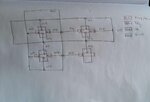Arokia
Newbie level 6
- Joined
- Oct 23, 2017
- Messages
- 12
- Helped
- 0
- Reputation
- 0
- Reaction score
- 0
- Trophy points
- 1
- Location
- RR Nagar, Bangalore
- Activity points
- 124

For example in the above image, we can understand that, the Nwell will have a higher doping concentration at its edges. But when we consider the OD layer, the <AND> operation of the P-implant and the OD layer is what creates the diffusion (ie the sorce or drain). So like the N-well, the edge of the OD will be the edge of the source or drain right? So if the OD layer does not have its own edge which is spaced apart from the transistors (npn or pnp), then why is it considered in the Well proximity effects in 28nm TSMC technology. Can someone please shed some light on this question.

